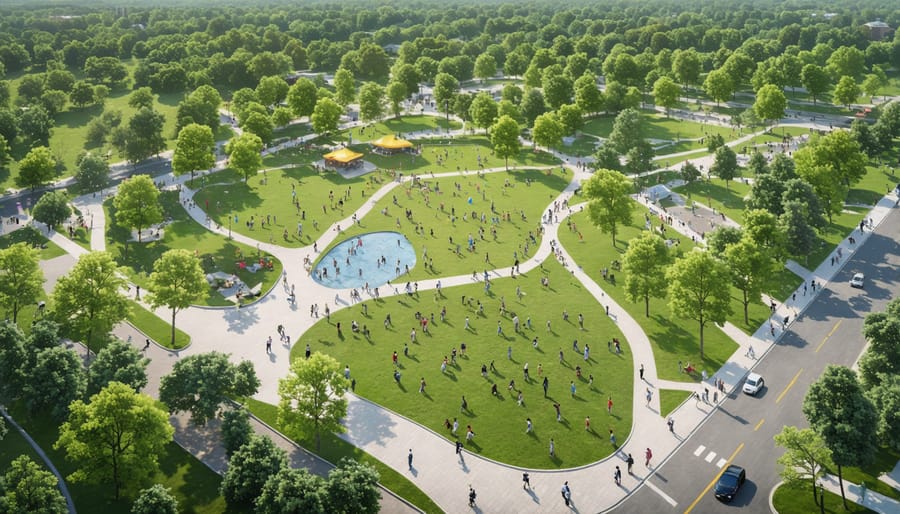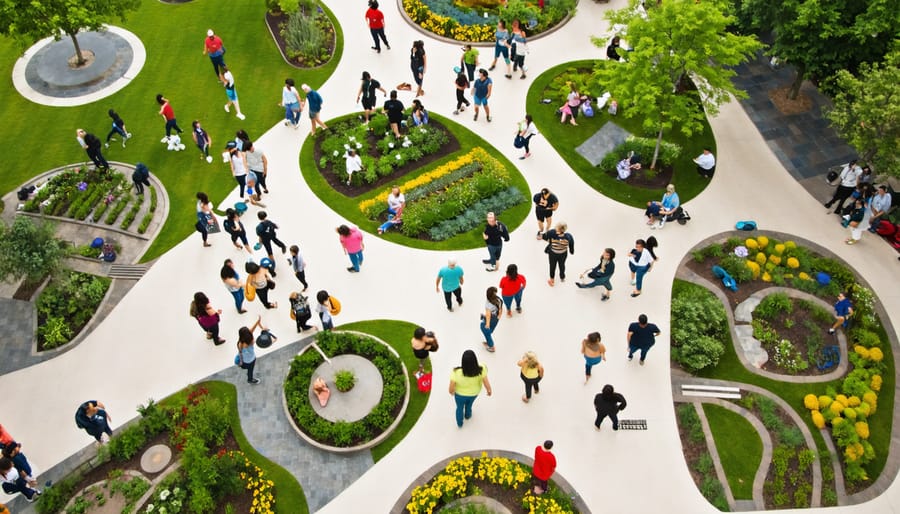When neighbors in Vancouver’s Mount Pleasant district launched their “Wellness Walks” initiative in 2022, they demonstrated how powerful community wellness programs can be. Starting with just 12 participants, this grassroots program now connects over 200 residents weekly for group exercise, health education, and social support. The program’s success lies in its simple yet effective approach: combining physical activity with neighborhood connection, making health promotion accessible to everyone regardless of fitness level or economic status. By partnering with local healthcare providers and businesses, the initiative has created a sustainable model for community-driven health improvement that addresses both physical and mental well-being. This remarkable example shows how local action can transform neighborhood health outcomes while building stronger social bonds.
Community Health Success: The Riverdale Park Initiative
From Unused Space to Wellness Center
In 2019, the residents of Maplewood County identified an underutilized space in their local park that had fallen into disrepair. Through community meetings and surveys, residents expressed a strong desire for accessible wellness facilities that would serve people of all ages and abilities.
The transformation began with a volunteer-led cleanup initiative that brought together over 200 community members. Local businesses contributed materials and equipment, while architectural students from the nearby university provided pro-bono design services. The municipal government matched community fundraising efforts, demonstrating the power of public-private partnerships.
The renovated space now features an accessible walking track, outdoor fitness equipment suitable for seniors and those with mobility challenges, and a community garden that provides fresh produce for local food banks. The wellness center also includes a covered pavilion for yoga classes, meditation sessions, and health education workshops.
What makes this project particularly successful is its ongoing community involvement. Local health professionals volunteer their time to lead fitness classes, while neighborhood associations organize regular maintenance days. The space has become a hub for health promotion activities, hosting weekly farmers’ markets in summer and indoor wellness programs during winter months.
This transformation showcases how community-driven initiatives can create sustainable health resources that serve diverse population needs while fostering social connections and promoting active living.

Building Community Through Active Living
Communities across Canada are embracing active living programs that bring neighbors together while promoting better health. Popular initiatives include weekly community walking groups, where residents of all ages meet at local parks or community centers for scheduled walks. These groups not only encourage physical activity but also create valuable social connections among participants.
Many neighborhoods have implemented “Active Transportation” programs, transforming unused spaces into community gardens, bike paths, and outdoor fitness stations. These spaces serve as gathering points where residents can exercise together, share gardening tips, and build lasting friendships while staying active.
Local recreation centers have expanded their offerings to include free or low-cost fitness classes, making exercise more accessible to everyone. Programs like “Senior Fit” and “Family Fun Fitness” create inclusive environments where community members support each other’s health goals. Some centers also offer specialized programs for chronic disease management and mental health support through movement.
Youth engagement has been particularly successful through after-school sports programs and intergenerational activities. These initiatives often pair seniors with young people for activities like tai chi or gentle yoga, fostering understanding between generations while promoting physical activity.
The success of these programs relies heavily on volunteer coordinators and community champions who organize events, maintain facilities, and ensure everyone feels welcome and supported in their health journey.

Key Elements of Successful Community Health Support
Local Leadership and Volunteer Engagement
Local champions played a vital role in driving the community health initiative forward. City councillors Sarah Chen and Mark Thompson spearheaded the project, working closely with neighborhood associations to identify health priorities and mobilize resources. They recruited a dedicated team of 50 volunteers, including retired healthcare professionals, fitness instructors, and passionate community members.
These volunteers underwent specialized training to lead walking groups, organize healthy cooking demonstrations, and facilitate wellness workshops. Their commitment ensured consistent program delivery and helped build trust within the community. Local business owners also stepped up, with many offering spaces for activities and contributing healthy snacks for workshops.
The project’s success heavily relied on the “Community Health Champions” program, where volunteers received certification to become neighborhood wellness advocates. These champions served as bridges between healthcare providers and residents, helping to address cultural barriers and ensure programs remained accessible to all community members.
Regular volunteer appreciation events and ongoing training opportunities helped maintain enthusiasm and program sustainability, creating a strong foundation for long-term community health improvement.
Partnership with Health Organizations
Healthcare providers and community organizations play a vital role in promoting wellness through collaborative partnerships. Local medical clinics, hospitals, and public health units work alongside wellness experts to provide comprehensive community health resources and expertise. These partnerships often include family physicians offering preventive care guidance, nutritionists providing dietary counseling, and mental health professionals conducting support groups and workshops.
Many healthcare organizations contribute by sharing their facilities for community programs, offering professional expertise during health fairs, and participating in public education initiatives. They also help train community health workers and volunteers who serve as bridges between medical professionals and local residents.
These partnerships strengthen the overall health support system by combining clinical expertise with community outreach. For example, local hospitals might partner with community centers to offer regular health screenings, while mental health clinics collaborate with schools to provide youth counseling services. This integrated approach ensures that health promotion efforts are both professionally guided and community-focused.

Starting Your Own Community Health Initiative
Starting a community health initiative may seem daunting, but breaking it down into manageable steps makes it achievable. Begin by researching successful health initiatives in similar communities to learn from their experiences.
First, identify your community’s specific health needs through surveys and conversations with local residents. Focus on one or two key areas rather than trying to address everything at once. Common starting points include diabetes prevention, mental health support, or physical activity programs.
Next, build a core team of committed volunteers and seek partnerships with local healthcare providers, community centers, and businesses. These partnerships can provide resources, expertise, and meeting spaces. Consider approaching local health authorities for guidance and potential funding opportunities.
Develop a clear action plan with specific goals and timelines. Start small with manageable projects like weekly walking groups or monthly health education workshops. Document everything and collect feedback from participants to demonstrate your impact.
Create awareness through social media, community bulletin boards, and local media outlets. Consider hosting an informal community meeting to gather input and build support. Remember to follow proper health and safety guidelines and obtain necessary permits or insurance coverage.
Sustainability is key, so establish a reliable volunteer rotation system and secure ongoing funding through grants or community sponsorships. Celebrate small victories and adjust your approach based on community feedback and participation levels.
Community support for health promotion has proven to be a powerful force in creating healthier, more vibrant neighbourhoods across Canada. Through collaborative efforts, local initiatives have successfully improved access to wellness resources, encouraged physical activity, and fostered mental health awareness. The impact extends beyond individual health outcomes, creating lasting social connections and sustainable support systems that benefit entire communities. By taking action today – whether through volunteering, participating in local health programs, or initiating new wellness projects – each of us can contribute to building stronger, healthier communities. Together, we can create positive change that promotes better health outcomes for current and future generations, making our communities more resilient and health-conscious than ever before.

